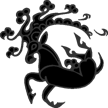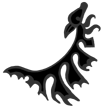by Chris Bennet
 The Scythians were a barbaric group of pre-Common Era nomadic tribes who are a fascinating example of an ancient cannabis using group. The Scythians played a very important part in the Ancient World from the seventh to first century BC. They were expert horsemen, and were one of the earliest peoples to master the art of riding and using horse-drawn covered wagons. This early high mobility is probably why most scholars credit them with the spread of cannabis knowledge throughout the ancient world. Indeed, the Scythian people travelled and settled extensively throughout Europe, the Mediterranean, Central Asia, and Russia, bringing their knowledge of the spiritual and practical uses for cannabis with them.
The Scythians were a barbaric group of pre-Common Era nomadic tribes who are a fascinating example of an ancient cannabis using group. The Scythians played a very important part in the Ancient World from the seventh to first century BC. They were expert horsemen, and were one of the earliest peoples to master the art of riding and using horse-drawn covered wagons. This early high mobility is probably why most scholars credit them with the spread of cannabis knowledge throughout the ancient world. Indeed, the Scythian people travelled and settled extensively throughout Europe, the Mediterranean, Central Asia, and Russia, bringing their knowledge of the spiritual and practical uses for cannabis with them.
 Scythian Society & Dress
Scythian Society & Dress The Scythians (as the Greeks referred to them) or Sakas (as the Persians knew them) are believed to have been of Iranian origin. They shared a common language, and maintained well-used trade routes that connected their many distant settlements. Although they were nomadic, the Scythians had a single patriarchal sovereign that the different chieftains all paid tribute to. This leader had an entourage of wealthy nobles who acted as his courtiers, and his position was passed on to his son at his death.
The Scythians (as the Greeks referred to them) or Sakas (as the Persians knew them) are believed to have been of Iranian origin. They shared a common language, and maintained well-used trade routes that connected their many distant settlements. Although they were nomadic, the Scythians had a single patriarchal sovereign that the different chieftains all paid tribute to. This leader had an entourage of wealthy nobles who acted as his courtiers, and his position was passed on to his son at his death.
 The Scythians had no written language, so much of what is known about them has been derived from the many precious and exquisitely crafted artifacts found in their frozen tombs in Russia, Kazyktstan and the Eurasian plains. These precious items included weapons, jewelry and clothing, and were meant to follow the deceased into the afterlife. They can be viewed in Russian museums, well preserved from their long stay in the frozen tombs.
The Scythians had no written language, so much of what is known about them has been derived from the many precious and exquisitely crafted artifacts found in their frozen tombs in Russia, Kazyktstan and the Eurasian plains. These precious items included weapons, jewelry and clothing, and were meant to follow the deceased into the afterlife. They can be viewed in Russian museums, well preserved from their long stay in the frozen tombs.
 The Encyclopedia Britannica describes the Scythian wardrobe as follows:
The Encyclopedia Britannica describes the Scythian wardrobe as follows:
 Many Royal Scyths wore bronze helmets and chain-mail jerkins of the Greek type, lined with red felt. Their shields were generally round and made of leather, wood, or iron, and were often decorated with a central gold ornament in the form of an animal, but other tribesmen carried square or rectangular ones.
Many Royal Scyths wore bronze helmets and chain-mail jerkins of the Greek type, lined with red felt. Their shields were generally round and made of leather, wood, or iron, and were often decorated with a central gold ornament in the form of an animal, but other tribesmen carried square or rectangular ones.
 All used a double-curved bow, shooting over the horse’s left shoulder; arrows had trefoil-shaped heads made, according to date, of bronze, iron, or bone. Arrows and bow were carried in a gorytos (bow case) slung from the left side of the belt.
All used a double-curved bow, shooting over the horse’s left shoulder; arrows had trefoil-shaped heads made, according to date, of bronze, iron, or bone. Arrows and bow were carried in a gorytos (bow case) slung from the left side of the belt.
 Their swords were generally of the Persian type, with an intricately ornamented heart-shaped or triangular crosspiece. …the sheaths were often encased in gold worked into embossed designs and offset with paste or ivory inlay and gems.
Their swords were generally of the Persian type, with an intricately ornamented heart-shaped or triangular crosspiece. …the sheaths were often encased in gold worked into embossed designs and offset with paste or ivory inlay and gems.
 Their knives were of various shapes and lengths, some being curved in the Chinese manner. They wore the dagger attached to the left leg by straps, and many carried spears or standards surmounted by bronze terminals depicting real or imaginary beasts.
Their knives were of various shapes and lengths, some being curved in the Chinese manner. They wore the dagger attached to the left leg by straps, and many carried spears or standards surmounted by bronze terminals depicting real or imaginary beasts.
 The Scythian’s horses were also outfitted in beautiful and ornate costumes, and were seen ridden for the first time among many of the peoples they descended upon.
The Scythian’s horses were also outfitted in beautiful and ornate costumes, and were seen ridden for the first time among many of the peoples they descended upon.
 Many of the Scythians had full body tattoos with extremely intricate tribal designs, depicting both real and imaginary beasts as well as events from their mythology. Looking like the forerunners of modern-day Hell’s Angels, the fierce appearance of the Scythian nomads had a formidably terrifying effect on the people whose lands they invaded.
Many of the Scythians had full body tattoos with extremely intricate tribal designs, depicting both real and imaginary beasts as well as events from their mythology. Looking like the forerunners of modern-day Hell’s Angels, the fierce appearance of the Scythian nomads had a formidably terrifying effect on the people whose lands they invaded.
 The astonishing victories of the Scythians brought them a great deal of fame, and much of Western Persia fell under the rule of Scythian chieftains. It has been recorded that they invaded Syria and Judea around 625 BC, and even reached the borders of Egypt where peace terms were reached with them by the intimidated rulers of that kingdom.
The astonishing victories of the Scythians brought them a great deal of fame, and much of Western Persia fell under the rule of Scythian chieftains. It has been recorded that they invaded Syria and Judea around 625 BC, and even reached the borders of Egypt where peace terms were reached with them by the intimidated rulers of that kingdom.
 Equality in War
Equality in War The act of war was one in which the Scythian women are said to have participated in equally with the men. Scythian women were tattooed like their mates, and the ancient historian Diordorus commented that Scythian women ‘fight like the men and are nowise inferior to them in bravery’.
The act of war was one in which the Scythian women are said to have participated in equally with the men. Scythian women were tattooed like their mates, and the ancient historian Diordorus commented that Scythian women ‘fight like the men and are nowise inferior to them in bravery’.
 It has been recorded that Scythian women had to kill three enemies in battle before marrying, and that a mastectomy of the right breast was performed on female infants so that their pectoral muscle wouldn’t weaken and they would be able to brandish a sword better!
It has been recorded that Scythian women had to kill three enemies in battle before marrying, and that a mastectomy of the right breast was performed on female infants so that their pectoral muscle wouldn’t weaken and they would be able to brandish a sword better!
 The Cimmerian Connection
The Cimmerian Connection It was the horseback riding Scythians who overtook the fierce Cimmerian infantry, which fought on foot and didn’t have horses.
It was the horseback riding Scythians who overtook the fierce Cimmerian infantry, which fought on foot and didn’t have horses.
 Most readers will probably be familiar with the Cimmerians as the people who were later popularized in the famous fictional tales of the displaced Hyperborean Era warrior, Conan the Cimmerian, by Robert E. Howard and later L. Sprague DeCamp. The fierce horseback-riding raiders in the scene at the beginning of macho director John Milius’, Conan the Barbarian, who rape and pillage the young Conan’s tribe, are meant to depict the ancient Scythians.
Most readers will probably be familiar with the Cimmerians as the people who were later popularized in the famous fictional tales of the displaced Hyperborean Era warrior, Conan the Cimmerian, by Robert E. Howard and later L. Sprague DeCamp. The fierce horseback-riding raiders in the scene at the beginning of macho director John Milius’, Conan the Barbarian, who rape and pillage the young Conan’s tribe, are meant to depict the ancient Scythians.
Cannabis and the Dead Cannabis was an integral part of the Scythian cult of the dead, wherein homage was paid to the memory of their departed leaders. After the death and burial of their king, the Scythians would purify themselves by setting up small tepee-like structures which they would enter to inhale the fumes of hemp seeds (and the resinous flower calyxes surrounding the seeds) thrown onto red-hot stones.
Cannabis was an integral part of the Scythian cult of the dead, wherein homage was paid to the memory of their departed leaders. After the death and burial of their king, the Scythians would purify themselves by setting up small tepee-like structures which they would enter to inhale the fumes of hemp seeds (and the resinous flower calyxes surrounding the seeds) thrown onto red-hot stones.
 In a famous passage written in about 450 B.C., Herodotus describes these funeral rites as follows:
In a famous passage written in about 450 B.C., Herodotus describes these funeral rites as follows:
…when, therefore, the Scythians have taken some seed of this hemp, they creep under the cloths and put the seeds on the red hot stones; but this being put on smokes, and produces such a steam, that no Grecian vapour-bath would surpass it. The Scythians, transported by the vapour, shout aloud.